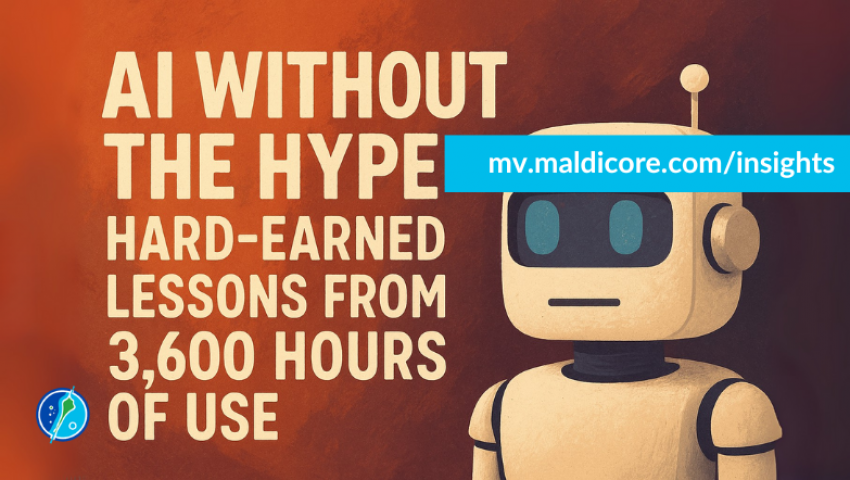
AI Without the Hype: Hard-Earned Lessons from 3,600 Hours of Use
After 3,600+ hours building and using AI, here’s what really matters in 2025, tools, limits, surprises, and how Maldicore frames the future.
It’s past midnight, the city outside is asleep, but the glow of an AI chat window keeps one person locked in a dialogue with code, strategy notes, and endless “what if” questions. That’s been our rhythm for three years straight. Not casual tinkering, not chasing hype, but logging over 3,600 hours of applied use, drafting reports, planning negotiations, building internal frameworks, refining copy, debugging code, even social media ads and testing business models in simulation.
That time wasn’t glamorous. It wasn’t about writing think-pieces from the sidelines. It was a grind of trial and error, chasing clarity through prompts, experiments, and failed outputs until something clicked. And when it did, the results didn’t just save hours, they rewired entire workflows.
So when people ask, “Is AI overhyped?” our answer is simple: if you’ve spent less than a hundred hours actually working with these tools, you don’t have the standing to judge. Experience is the only filter that cuts through noise.
The Mirage of Certainty
The AI conversation today is dominated by extremes. On one side, doom prophets insist jobs will vanish overnight. On the other, skeptics dismiss AI as overblown autocomplete. Both camps have something in common: very few of them have logged serious hours using the tools.
A 2025 PwC survey revealed that 62% of executives cite AI as “strategically critical,” yet fewer than 18% have personally tested models beyond surface-level queries. This creates a mirage of certainty, loud takes built on thin soil.
We’ve seen this pattern before. In the 1980s, managers resisted spreadsheets, arguing that calculators were “good enough.” In the 1990s, teachers banned spellcheck, claiming it would “kill writing.” Every productivity leap begins with misplaced fear and misplaced confidence. AI is no different.
The truth: AI isn’t a crystal ball. It’s a tool. And like all tools, its value is determined by the craft of the person holding it.
How We Frame AI at Maldicore
At Maldicore, we treat AI as infrastructure, not magic. It’s the invisible scaffolding behind how we draft proposals, refine strategies, and accelerate execution. Our custom AI frameworks, designed to “understand” our brand tone and context, power everything from client minutes to negotiation prep.
We don’t outsource thinking to AI. We use it to multiply output. Just as the typewriter didn’t kill writing, AI won’t kill strategy, it just makes it faster to see options, test angles, and move from idea to execution.
We believe any company that embraces AI, even imperfectly, will outperform competitors that don’t. Not because AI is flawless, but because the speed advantage compounds. A proposal delivered in two hours instead of two days, a plan tested in simulation before the meeting, a brand guide drafted in hours instead of weeks, that advantage adds up.
And we’ve learned to approach AI with humility. Predictions about “what comes next” rarely matter. What matters is what you do with the models in front of you, today.
What 3,600 Hours Revealed
Numbers don’t lie. By integrating AI into daily operations, we’ve seen measurable gains:
Cycle-times shrank dramatically. A strategic report that once took a week now takes less than a day. That’s not speed for its own sake, it means responding to market shifts in real time.
Margins improved. Instead of hiring out every repetitive task, AI absorbed much of the workload, cutting external spend by 20–30%. Those savings translated directly into resilience during lean months.
Retention grew. Clients noticed the difference, not just in delivery speed, but in clarity and adaptability. Several renewals were secured because our AI-augmented process delivered sharper outputs, faster, without losing the Maldicore touch.
And perhaps the biggest payoff: creative range. AI gave us the ability to draft five possible futures in hours. That optionality allowed us to walk into negotiations, proposals, and boardrooms with confidence, knowing we’d mapped risks and opportunities others hadn’t even considered.
Old Habits vs. AI Habits
One of the sharpest lessons was behavioral. Professionals who thrive with AI don’t just change tools, they change habits.
- Old habit: apologizing for using AI, as if it were “cheating.” New habit: owning AI as the natural extension of modern productivity.
- Old habit: starving models of context. New habit: token maximalism, giving the system more, not less, so outputs are richer.
- Old habit: thinking prompt engineering is everything. New habit: treating AI like a partner, not a puzzle, clarity of intent beats clever phrasing every time.
- Old habit: assuming AI can’t be creative. New habit: realizing that creativity is reciprocal, feed it bold ideas, get bold outputs.
These shifts aren’t cosmetic, they separate amateurs from those who actually extract value.
Tools, Not Oracles
If history teaches anything, it’s that tools always spark fear before acceptance. When calculators arrived, schools banned them. When word processors emerged, critics said spellcheck would “rot language.” Yet today, nobody questions their place.
AI sits in this lineage. Its destiny is not to replace thought, but to absorb drudgery. The problem isn’t that people use it too much, it’s that they haven’t used it enough to discover its real edges.
Like all tools, AI’s value lies in practice, not prediction.
Case Study Breakout: A Negotiation in Hours
One of our clients faced a critical negotiation with a regional distributor. Historically, preparing would have taken weeks of analyst work, market scans, pricing simulations, risk assessments. Instead, we fed the AI every internal report, contract draft, and regional study we had. Within hours, we had scenario maps, counterparty analysis, and five possible deal-structures ready.
The result? A negotiation playbook that looked like it took weeks, delivered in days. The client walked into the meeting prepared for every angle. The deal closed two weeks earlier than projected and at a margin 8% higher than forecast.
That’s what 3,600 hours of practice buys you: fluency in bending the tool to context.
Risk Matrix: Where People Go Wrong
- High Probability / High Impact: Underuse. The biggest risk isn’t AI replacing you, it’s you refusing to use it. Fear keeps adoption low, and low adoption guarantees competitive lag.
- Medium Probability / Medium Impact: Outdated models. Sticking with obsolete systems (like GPT-4o) produces shallow outputs. Better models exist, use them.
- Low Probability / High Impact: Compliance negligence. Many lawyers panic about data protection without even reading the terms of service. The real risk is blind spots, not breaches.
Every risk we’ve seen is human-driven, not model-driven. People, not technology, are the bottleneck.
The Underhyped Opportunity
Here’s a contrarian take: AI is still underhyped.
Even if models stopped improving today, we’d have a decade of integration value to unlock. Enterprise systems, workflows, and training pipelines haven’t even begun to exhaust what’s possible.
The real race isn’t model-to-model. It’s between AI-native platforms building new workflows and incumbents like Google and Microsoft trying (and failing) to stitch AI into legacy products. That tension will define the next five years of value creation.
For businesses, the play is simple: adopt now, adapt fast, and let the slow movers price themselves out.
If Nothing Else, Take-Home This
After 3,600 hours of applied use, the truth is simple. AI won’t save you, but ignoring it will hurt you. The winners aren’t the loudest pundits or the boldest forecasters, they’re the ones quietly, relentlessly using the tools to compress time and expand options.
If you’re still on the sidelines, afraid to start, afraid to look “inauthentic”, this is your invitation. We’re offering a short, introductory class designed to demystify AI and give you a safe space to practice the basics.
You don’t need fancy prompts. You don’t need perfect technique. You just need to start.
Join us at yusufshunan.com/chatgpt1 .
The only mistake left is waiting.
— The Maldicore Team

Maldicore Support
Leave a comment
Your email address will not be published. Required fields are marked *

